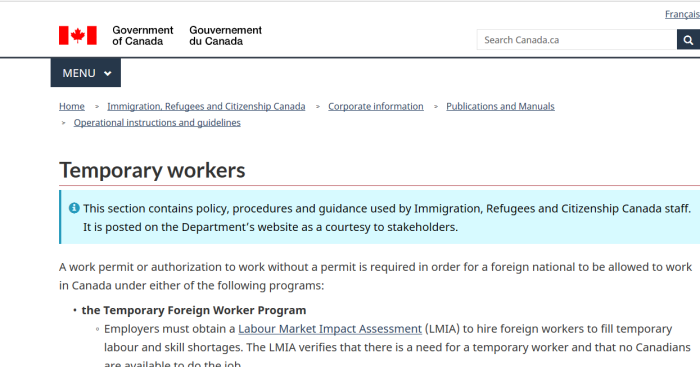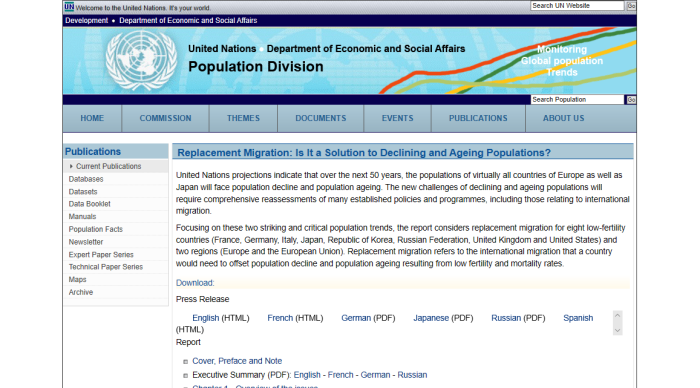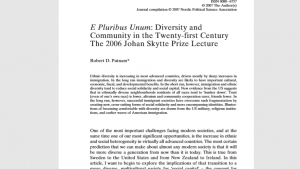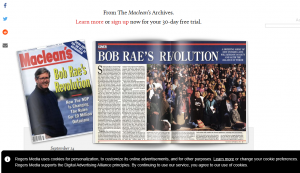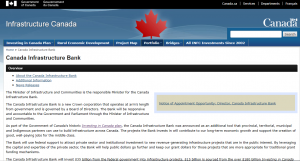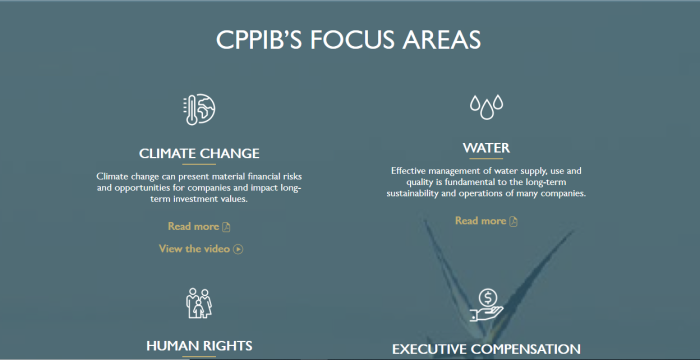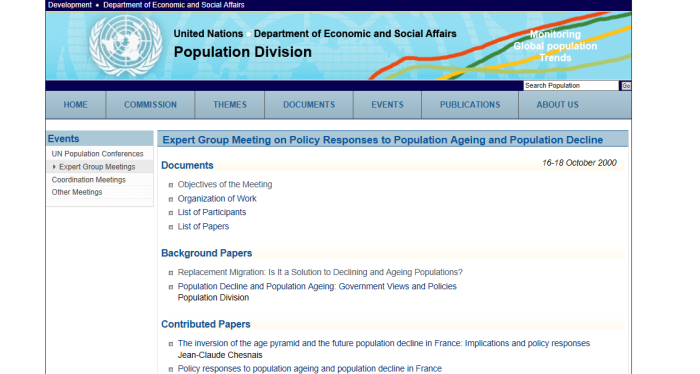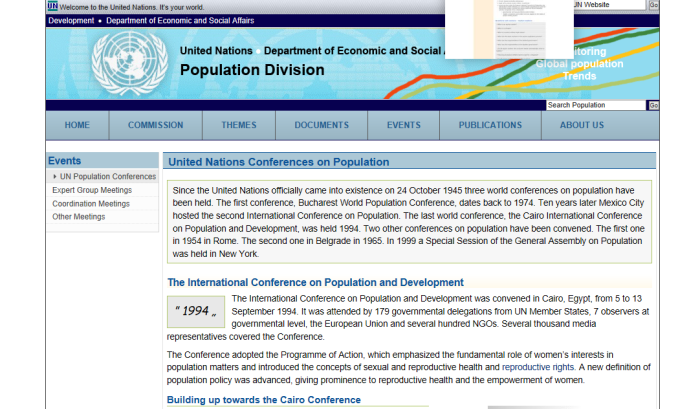(Source: Globe and Mail)

(Source: Globe and Mail, 2012)
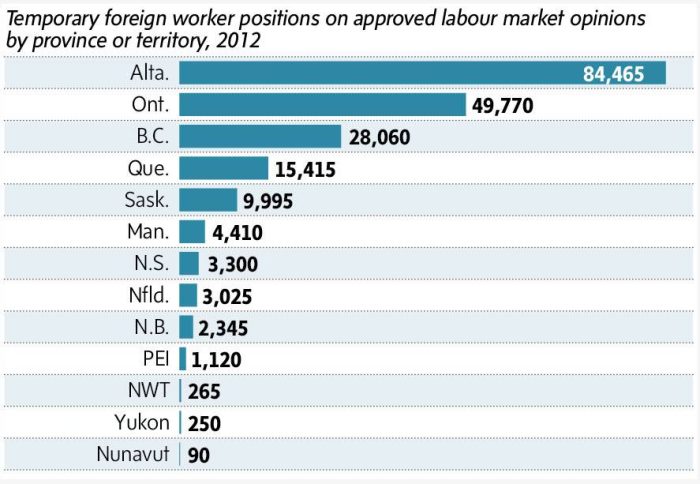
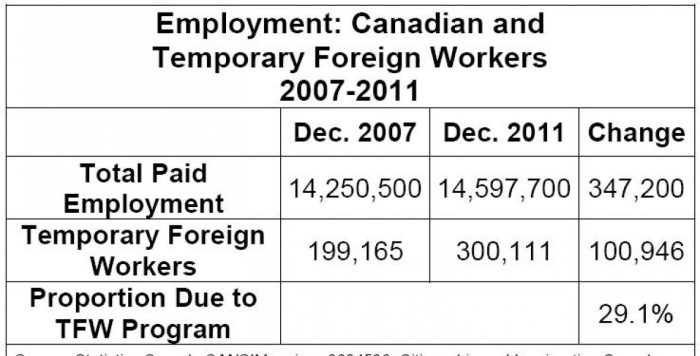
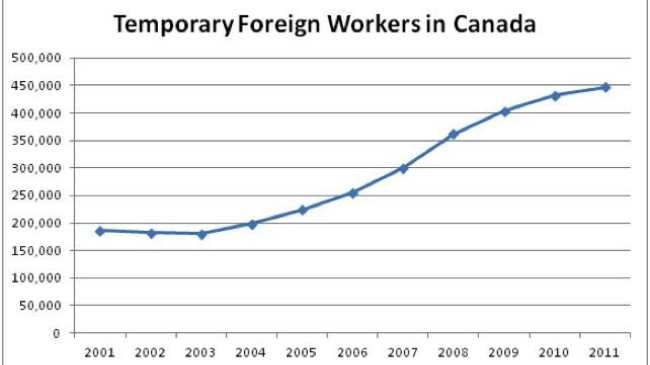
Disclaimer: When this piece was originally written, the number of 150,000 student visas was used. This was based on an error in reading the 2018 report. Canada actually admitted some 317,000 students in 2017. While not all will stay, most will want to and try to after graduating.
1. Mass LEGAL Immigration In Canada
Despite what many think, LEGAL immigration into Canada is actually a much larger threat than illegal aliens, given the true scale of the replacement that is happening. What was founded as a European (British) colony is becoming unrecognizable due to forced demographic changes. There are also social, economic, environmental and voting changes to consider. See this Canadian series, and the UN programs for more detail. Politicians, the media, and so-called “experts” have no interest in coming clean on this.
CLICK HERE, for UN Genocide Prevention/Punishment Convention.
CLICK HERE, for Barcelona Declaration & Kalergi Plan.
CLICK HERE, for UN Kalergi Plan (population replacement).
CLICK HERE, for UN replacement efforts since 1974.
CLICK HERE, for tracing steps of UN replacement agenda.
Note: If there are errors in calculating the totals, please speak up. Information is of no use to the public if it isn’t accurate.
2. Important Links
(1) http://www.pbo-dpb.gc.ca/web/default/files/files/files/TFW_EN.pdf
(2) http://archive.is/PpLay
(3) “https://www.oecd.org/migration/forum-migration-statistics/3.Feng-Hou.pdf
(4) http://archive.is/jdJCG
(5) https://www150.statcan.gc.ca/n1/daily-quotidien/180129/dq180129b-eng.htm
(6) http://archive.is/wip/ei9Dz
(7) https://lop.parl.ca/sites/PublicWebsite/default/en_CA/ResearchPublications/201479E#a2
(8) http://archive.is/bCntt
(9) https://www.canada.ca/en/immigration-refugees-citizenship/services/immigrate-canada/atlantic-immigration-pilot/hire-immigrant.html
(10) http://archive.is/wm5PH
(11) http://www.vancouversun.com/Temporary+foreign+workers+Filling+labour+depressing+wages/7564651/story.html
(12) http://archive.is/paYCu
(13) https://globalnews.ca/news/3993108/temporary-foreign-workers-canada-unemployment/
(14) http://archive.is/wip/AEfJ7
(15) https://www.canada.ca/en/immigration-refugees-citizenship/services/immigrate-canada/provincial-nominees.html
(16) http://archive.is/wip/5b98A
(17) https://www.canadavisa.com/international-mobility-program.html#gs.6o5qw9
(18) http://archive.is/wip/OWMPt
(19) https://www150.statcan.gc.ca/n1/daily-quotidien/181128/dq181128c-eng.htm
(20) http://archive.is/wip/WfpUk
(21) https://www.statcan.gc.ca/eng/dai/smr08/2018/smr08_220_2018
(22) http://archive.is/wip/X10Rm
(23) https://www150.statcan.gc.ca/t1/tbl1/en/tv.action?pid=3710001101
(24) http://archive.is/9vhYZ
(25) https://www.canada.ca/en/immigration-refugees-citizenship/corporate/publications-manuals/annual-report-parliament-immigration-2018/report.html
(26) http://archive.is/Nov56
(27) https://www150.statcan.gc.ca/t1/tbl1/en/tv.action?pid=1710000901
(28) http://archive.is/0yxKJ
(29) https://www150.statcan.gc.ca/n1/daily-quotidien/180927/dq180927c-eng.htm
(30) http://archive.is/JgvqV
Categories to Consider:
- Regular immigration — 310,000 currently
- Temporary Foreign Worker (TFW) — 78,788 in year 2017
- International Mobility Program — 224,033 in year 2017
- International Students — 317,328 in 2017
- “Refugees” — 44,747 in year 2017
3. More Information
Facts and Figures
More than 192,000 temporary foreign workers entered Canada in 2011. The overall total includes about 70,000 foreign workers whose employer required an LMO from HRSDC and close to 120,000 who did not require an LMO.
In 2011, more than 29,000 temporary foreign workers made the transition to permanent status.
Guess it’s not really “temporary”.
Advantages to Employers
For employers who have been unable to recruit Canadian citizens or permanent residents for job openings, the TFWP makes it possible to hire workers from abroad. Employers might also find a qualified foreign worker already in Canada, such as a foreign worker who is about to complete a job contract with another employer or a foreign national holding an open work permit that allows the employee to work for any employer in Canada.
While most temporary foreign workers will be hired to address a specific, short-term labour need, some temporary foreign workers who initially came to fill a temporary vacancy can transition to permanent residence if they meet certain requirements. For example, the Canadian Experience Class is open to foreign nationals who have been working full-time in Canada as trades people or in managerial or professional occupations and meet certain other requirements. Other foreign workers may qualify through the Provincial Nominee Program for permanent residence in Canada. These routes exist to ensure that workers who have shown that their skills are in continuing demand and that they have already adapted well to life in Canada can build a future here.
As the TFWP is designed to help employers fill short-term gaps in Canada’s labour market, most temporary foreign workers are limited to working in Canada for four years before having to return to their home country. Most TFWs have the opportunity to apply for permanent residence if that is their desire, and limiting the amount of time they may work in Canada with a temporary status encourages them to do so.
Yeah, it’s not really “temporary”.
And how many are we talking about anyway?
“A. Temporary Workers
In 2017, a total of 78,788 work permits were issued under the Temporary Foreign Worker Program (TFWP), which includes caregivers, agricultural workers and other workers who require a Labour Market Impact Assessment (LMIA).”
| Year | Female | Male | Total |
|---|---|---|---|
| 2015 | 14,884 | 58,132 | 73,016 |
| 2016 | 16,013 | 62,367 | 78,402 |
| 2017 | 14,380 | 64,408 | 78,788 |
Well, if nothing else the TFW category is down from the Harper years. Though, to be fair, I think this is “per year” admittants, not the total in the country at a time.
4. Provincial Nominee Programme
How the Provincial Nominee Program (PNP) works
This program is for workers who:
- have the skills, education and work experience to contribute to the economy of a specific province or territory
- want to live in that province, and
- want to become permanent residents of Canada
Each province and territory
Footnote
* has its own “streams” (immigration programs that target certain groups) and requirements. For example, in a program stream, provinces and territories may target:
- students
- business people
- skilled workers
- semi-skilled workers
If “temporary” foreign workers cannot get PR status Federally, then there is a good chance they can Provincially.
Now this is encouraging:
As part of the process, you will have to pass a medical exam and get a police check (certificate). Everyone must have these checks, no matter where they plan to live in Canada.
However, being healthy and of good conduct does “not” apply to refugee applicants.
Note: In 2017, the number of PN admissions was 49,724.
(Source is here)
5. International Students Fast Tracked To PNP
Although this article was meant to address the Temporary Foreign Worker’s Program (TFWP), it should also be noted that international students completing a college diploma or university degree are often accepted into the PNP as well. So it is worth looking at how many people that involves.
Number of international students increasing at a higher rate than that of Canadian students
The number of international students enrolled in Canadian postsecondary institutions has been on the rise for two decades, with their numbers increasing at a higher rate than that of Canadian students. International students totaled 245,895 in 2016/2017, representing 12.0% of overall enrolments.
Increases in international student enrolments in Canada are observed due to a variety of factors, including programs and policies put in place to increase their numbers, the quality of postsecondary education, and the appeal of Canada as a study destination. While China remained the top country of citizenship for international students in 2016/2017, most of the gains in enrolments of international students from 2015/2016 to 2016/2017 were a result of the growing number of students from India, up 34.4% (+9,060).
245,895 international students in the 2016/2017 year, and we can expect that number to grow. Of course, Permanent Resident status is often straightforward after that. From there, citizenship is really just a formality.
Now, we are told that Canada currently has an immigration intake of 310,000 per year (although scheduled to increase). This does not take the 317K (listed in 2017) of international students.
2018 REPORT TO PARLIAMENT ON IMM
In 2017, a total of 44,747 people were admitted to Canada as resettled refugees, as permanent residents in the Protected Persons in Canada category or as people admitted for humanitarian and compassionate considerations and under public policies.
Some other facts:
-In 2017, Canada admitted 159,262 permanent residents in Economic Class programs, representing 55.6% of all 2017 admissions.
-In 2017, Canada admitted 65,417 new permanent residents in the Economic Class through the Express Entry application management system, an increase of 32,003 from the previous year.
Of the 49,724 admissions under the Provincial Nominee Program, 13,531 were through Express Entry, an increase of 73% over 2016.
-In 2017, IRCC admitted 22,253 caregivers as permanent residents. This was above the high end of the planned admissions and reflected measures to reduce the inventory of applicants that applied under the former Live-in Caregiver Program.
-In 2017, a total of 587 admissions were processed through Federal Economic – Business Immigration programs.
6. You Can’t Make This Up!
Of the 286,479 permanent residents admitted in 2017, a total of 76% self-identified as having knowledge of English, French or both official languages, which is an increase of three percentage points compared to 2016.
Okay, apparently you speak English of French if you “identify” as doing so.
7. How Many People Total?


A few assumptions:
(1) Although International Mobility is “meant” to be temporary, visa holders absolutely can find ways to obtain other visas, or apply for PR in certain cases, so count the entire amount.
(2) Data for 2017 lists some 317K student visas. While it is certainly true that not all will stay afterwards, the vast majority will want to.
| Category | Number |
|---|---|
| Permanent Immigration | 310,000 |
| Temp Foreign Worker | 80,000 |
| International Mobility | 225,000 |
| International Student | 315,000 |
| “Refugees” | 45,000 |
Of course, these are estimates from older data. They do not include other categories, or the hordes of illegals coming into Canada. It also doesn’t include any other program that may not be listed.
975,000 in a year. More than 1/2 million more than our “leaders” are telling us.
8. Bernier V.S. Trudeau
What we are “told” the numbers are
| Who | Current | Proposed | Diff | Percent |
|---|---|---|---|---|
| Trudeau | 310K | 350K | +40K | +13% |
| Bernier | 310K | 250K | -60K | -20% |
What the numbers “actually” are:
| Who | Current | Proposed | Diff | Percent |
|---|---|---|---|---|
| Trudeau | 975K | 1,015K | +40K | +4% |
| Bernier | 975K | 915K | -60K | -6% |
And of course, this is presupposed on the idea that there are only 810,000 legal immigrants into Canada this year.
4% increase with “open borders” Trudeau.
6% decrease with “populist” Bernier.
What a complete scam.
(Added June 17, 2019). This is Maxime Bernier calling out the “globalist” Trudeau and Scheer for supporting mass migration.
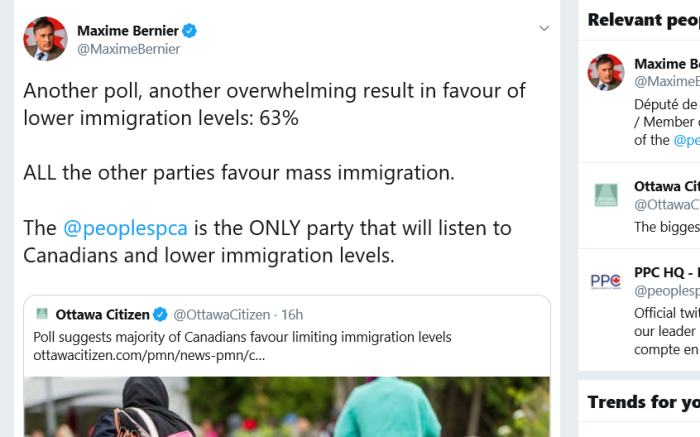
9. StatsCan Information
CLICK HERE, for 2018-2019 estimates.
Statistics Canada estimates that from 2019 to 2019
Q1 in 2018 = 36,786,021
Q2 in 2018 = 36,890,169
Q3 in 2018 = 37,058,856
Q4 in 2019 = 37,242,571
Q1 in 2019 = 37,314,442
This would be an increase of 525,000, which is 215,000 or 70% higher than what we have been told. But there’s more.
StatsCan found most growth came from migration.
The number of non-permanent residents increased by 165,729 in 2017/2018. This increase surpassed the previous peak in 1988/1989, the year when the Immigration and Refugee Board of Canada was created and the new refugee determination system was introduced. Although also fed by a strong increase of asylum seekers, the increase of the number of non-permanent residents in the country in 2017/2018 was still mainly explained by the rise in the number of work and study permit holders.
So, another 525,000 new citizens, and another 165,000 new residents
That would be 690,000 people.
Let’s see some census data.
In 2011, there were 33,476,688 Canadians.
In 2016, there were 35,151,728 Canadians.
This is a difference of 1.68M, or 335,000/annually.
But this only takes into account “citizens”, not permanent residents, or other temporary residents.
Even using StatsCan data, the 800K+ estimate seems pretty reasonable, when other groups are factored in.
And to reiterate: not everyone who comes into Canada on a “temporary” path will stay. But the majority will want to and try to.
Disclaimer: When this piece was originally written, the number of 150,000 student visas was used. This was based on an error in reading the 2018 report to Parliament. Canada actually admitted some 317,000 students in 2017. While not all will stay, most will want to and try to after graduating.


